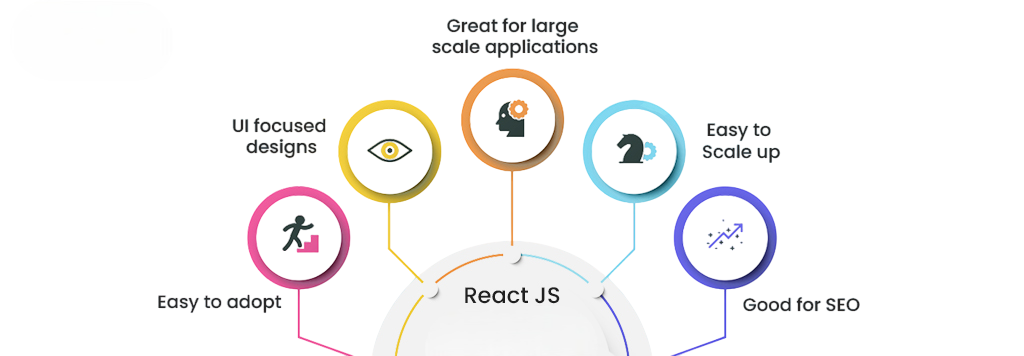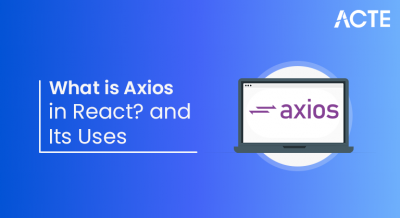
- React.js and Node.js
- Getting Started with React.js
- Important React.js Features
- Top React-Powered Websites
- Understanding Node.js
- Differences Between React.js and Node.js
- When to Use React.js
- When to Use Node.js
- Performance Comparison
- React.js with Node.js (Full-Stack Development)
- Learning Curve: React.js vs Node.js
- Choosing the Right Technology for Your Project
React.js and Node.js
React.js, also known as React or ReactJS, is a free and open-source JavaScript front-end library for creating user interfaces using UI components. A popular tool for making dynamic and interactive single-page applications (SPAs), it was created by Facebook. An open-source, cross-platform JavaScript runtime environment called Node.js enables programmers to run JavaScript code anywhere other than a web browser, usually on the server side, making it an essential part of Full Stack Training . The development stack is unified since it permits the usage of JavaScript for both front-end and back-end development. Combining React.js and Node.js results in a potent full-stack development environment that enhances productivity, speed, and performance in web application development by enabling developers to use JavaScript for both the front end and back end.
Getting Started with React.js
Facebook created the JavaScript library React.js, commonly referred to as React. React.js is mostly used by developers to create web application user interfaces (UIs). By breaking up the user interface into reusable components, React.js’s component-based architecture promotes efficiency and modularity in the development process, especially when building Node .js Apps . Understanding fundamental ideas like components, properties, and state as well as UI code authoring tools like JSX (JavaScript XML) are necessary to get started with React. React.js is a great option for creating quick, scalable, and intuitive single-page apps because of its modular design and robust community support.
Important React.js Features
Virtual DOM: One important element of React.js is the Virtual DOM (Document Object Model). React is able to render and update UI elements more quickly because of the Virtual DOM, a thin and light version of the real DOM. React enhances performance by selectively updating the necessary portions when data changes by comparing the Virtual DOM to the real DOM. React.js facilitates component reusability, which allows programmers to design modular components that may be applied to other application sections. This enhances code organization and maintainability while also cutting down on development time. React employs a one-way data binding model, sometimes referred to as unidirectional data flow.

React.js is one of the most widely used front-end libraries for creating contemporary web applications because of its many strong features. React’s most noteworthy feature is the Virtual DOM, which, when combined with Redux in React , enhances speed and performance by enabling React to update and render components effectively by altering just the portions of the interface that require updating.
- Component reusability is another essential property that helps developers create self-contained, modular user interface components that may be used in many programme sections, saving time and minimising code duplication.
- Additionally, React facilitates unidirectional data flow, or one-way data binding, which improves data management predictability and debugging.
React makes UI creation easier while preserving great efficiency and flexibility for producing dynamic and interactive user experiences thanks to its component-based design and JSX syntax.
Are You Interested in Learning More About Full Stack Developer? Sign Up For Our Full Stack Developer Training Today!
Top React-Powered Websites
React is a popular framework that many well-known websites in a variety of industries use. The New York Times, Uber, Airbnb, Netflix, and Meta are just a few of the well-known businesses that have selected React for their web development requirements.
- Facebook: Ten years ago, the Facebook team first created the React.js library. Later, they created React Native for developing mobile applications. Facebook has been able to create a unique visual style for their website and app by using this framework.
- Netflix: Netflix wants to provide high-quality services with a focus on consumer satisfaction. The Netflix team embarked on a redesign project in 2015, implementing a React Native Image and React user interface (UI).
- Uber: Since its founding, the Uber engineering team has used React Native features to develop a number of open-source frameworks. Additionally, using React, the team has created Base Web, a design system that provides reusable UI components, making it possible to create device-agnostic user interfaces.
- Airbnb: The front end of a well-known vacation rental website uses React, which allows web page elements to load quickly and precisely on different devices. The expansion of Airbnb has been made possible in large part by the inclusion of React.
Understanding Node.js
Developers can run JavaScript code outside of a web browser with Node.js, an open-source, cross-platform JavaScript runtime environment. It is based on the fast and effective V8 JavaScript engine found in Chrome. Neither blocking nor asynchronous: One of Node.js’s primary characteristics is its asynchronous and non-blocking nature. In contrast to conventional server-side technologies, which handle requests synchronously, Node.js uses an event-driven design.
- Node.js may now start several processes at once without waiting for one to finish before starting the next thanks to this. With the integration of the React Carousel Component , Node.js effectively handles several concurrent connections without preventing execution from continuing.
- Node.js is pre-installed with NPM (Node Package Manager), a comprehensive ecosystem of open-source libraries and packages. Node.js has cross-platform interoperability, which enables programmers to create apps for a variety of operating systems, including Linux, macOS, and Windows.
Developers may create code once and have it run on multiple platforms thanks to this flexibility, which removes the need for major changes. An effective option for multi-platform applications, Node.js’s cross-platform characteristics also makes it easier for developers working on different operating systems to collaborate.
Would You Like to Know More About Full Stack Developer? Sign Up For Our Full Stack Developer Training Now!
Differences Between React.js and Node.js
Both React.js and Node.js are well-liked in the JavaScript ecosystem because of their unique features and functions. By examining the main distinctions between React.js and Node.js, this section seeks to analyze their distinct advantages and applications.
- Node.js:
- Node.js is a server-side JavaScript runtime environment with the following goal. It enables programmers to run JavaScript code outside of a browser, mostly for creating web applications’ backends.
- It manages database connections, server-side logic, data management, and API interfaces.
- Real-time apps, APIs, and scalable web servers are all best made with Node.js.
- Function within an online application: As the backend, Node.js manages client requests, processes information, and replies, while the frontend may involve frameworks such as React js vs React Native for building dynamic user interfaces. React.js
- React.js is a front-end JavaScript library created especially for creating single-page apps and user interfaces (UIs).
- Functionality: It emphasizes developing reusable, dynamic, and interactive user interface elements. React optimizes performance for applications with intricate and dynamic user interfaces by effectively updating and rendering components using a virtual document object model.
- React.js serves as the frontend of a web application, controlling how users interact with and view the program on a mobile device or in their browser.
When to Use React.js
A JavaScript user interface development library called React.js is especially well-suited for apps that use dynamic data and intricate, interactive user interfaces. Here are some important situations when React.js is useful:
- Interactive and Complex User Interfaces: For example, social media feeds, dynamic cart e-commerce sites, dashboards with real-time data visualization, or applications that need a highly interactive and dynamic user interface with rapid data changes and user interactions.
- Single-Page Applications (SPAs): React is a great option for creating SPAs, which, as part of Full Stack Training , offer a more seamless user experience by allowing content to refresh dynamically without requiring complete page reloads and allowing the entire application to load once.
- Development Based on Components: The component-based architecture of React enables you to divide the user interface into separate, self-contained components, fostering code reusability and maintainability if you strive for a modular and reusable codebase.
- Large-Scale Applications: React is appropriate for complicated and large-scale applications where responsive user experience depends on effective rendering and updates thanks to its performance enhancements, such as the Virtual DOM.
When to Use Node.js
Numerous application types can benefit from Node.js’s adaptable runtime environment, especially those that require real-time functionality, scalability, and high speed.

- Chat programs
- Platforms for online gaming
- Editing tools for collaboration
- RESTful APIs
- Backend services for mobile and web apps
- Microservices architectures
- Backend Efficiency: Node.js is especially strong at backend performance, which is important for I/O-bound and event-driven applications such as streaming services, APIs, and real-time chat.
- Non-blocking I/O: Its non-blocking I/O method enables it to process many requests at once without causing the event loop to stall, giving low latency and great throughput.
- Scalability: Node.js is designed to expand by successfully handling logic and data on the server side, which makes it ideal for applications requiring a lot of concurrency. React.js Performance:
- Virtual DOM: It makes use of a virtual DOM to reduce the amount of direct DOM manipulation, which speeds up rendering and improves user experience.
- Effective Rendering: By batching modifications and updating components only when necessary, React improves rendering efficiency for user interface updates.
- Rendering on the server side (SSR): Server-side rendering is used by React-based frameworks like Next.js to enhance SEO and initial page loads. Principal Disparities in Performance Focus:
- Node.js: Server-side performance is gauged by throughput, latency, and request handling capacity.
- React.js: Performance is evaluated by client-side user interaction smoothness, rendering speed, and UI responsiveness.
- Focus: Creating user interfaces and front-end development.
- Concepts: Necessitates knowledge of novel ideas such as component-based architecture, state management, lifecycle functions, and JSX (a syntax extension that combines HTML and JavaScript).
- First Configuration: Because of the initial setup and the need to understand new concepts like Hooks and context APIs, it may seem overwhelming to novices.
- Emphasis on data management, server-side logic, APIs, and backend programming.
- Concepts: Because it utilizes the same fundamental language concepts as JavaScript, it is rather simple for those who are already familiar with it.
- Important Topics: Needs knowledge of event-driven models, asynchronous programming, and effective package management with npm.
In Actual Time Utilization: Node.js performs exceptionally well in settings where constant communication and real-time updates are essential. It is perfect for applications that need real-time data processing and delivery because of its event-driven, non-blocking architecture.
APIs as well as microservices: Node js is perfect for scalable applications and contemporary cloud-based services because of its efficient handling of multiple simultaneous requests, which guarantees quick data transmission and seamless system integration.
Applications for Streaming:Because of its exceptional ability to manage real-time data streams, Node.js is a perfect fit for systems that stream audio and video. Its event-driven, non-blocking architecture guarantees seamless playback and reduced latency by enabling continuous data flow without delays.
Single-Page Applications (SPAs): A development of dynamic and interactive single-page applications (SPAs) is made easy by Node.js’s seamless cooperation with front-end frameworks such as React, Angular, and Vue.js.
IoT Applications: Due to its event-based design and low energy use, Node.js is a good choice for IoT applications that need real-time data processing and communication between devices.
Preparing for Full Stack Development Job? Have a Look at Our Blog on Full Stack Development Interview Questions and Answers To Ace Your Interview!
Performance Comparison
In web development, React.js and Node.js have different features, and each has performance characteristics that fit to its task.
- Node.js Speed:
React.js is primarily focused on enhancing user interface responsiveness and optimizing frontend performance, while the React Native Framework extends these capabilities to mobile platforms, enabling developers to build high-performing, cross-platform applications with a consistent user experience.
React.js with Node.js (Full-Stack Development)
In full-stack development with React.js and Node.js, JavaScript-based technologies are utilized to create the client-side (frontend) and server-side (backend) components of a web application. React.js and Node.js offer a solid base for creating modern web applications. React.js shines in building UIs for single-page apps using reusable components, which boosts efficiency and consistency. Developers often explore concepts like What is React Checkbox to understand how interactive form elements can be efficiently managed within React’s component-based architecture. React uses JSX, mixing HTML-like syntax for more natural UI coding. State management tools like Redux or the Context API aid in handling app data, and React Router allows smooth navigation between views. On the backend, Node.js is a flexible JavaScript runtime for server-side tasks. Its non-blocking model handles many requests well, great for scalable apps. Frameworks such as Express.js simplify middleware, routing, and API creation.
Learning Curve: React.js vs Node.js
Depending on a developer’s prior experience and the particular area of web development they are concentrating on, the learning curve for React.js and Node.js varies.
- Learning Curve for React.js:
- Learning Curve for Node.js:
Choosing the Right Technology for Your Project
The selection between a full-stack JavaScript approach with Node.js and React.js or using them separately hinges on the web application’s demands. For apps needing a scalable backend and dynamic interface, Full Stack Training in React.js makes it apt for the user interface, interacting with a Node.js backend for business logic and data handling. If an existing backend already exists (e.g., Python, Ruby, Java), React.js can work independently on the front end, using the backend’s APIs. Conversely, Node.js alone is fit for real-time applications or backend services without a rich user interface, managing server-side tasks for various clients. This adjustability allows a choice of tools based on project needs. Additionally, teams can leverage full stack training to gain expertise in both React.js and Node.js, enabling them to design and develop end-to-end solutions efficiently. Understanding the strengths and limitations of each technology allows developers to make informed decisions about architecture, scalability, and performance.





